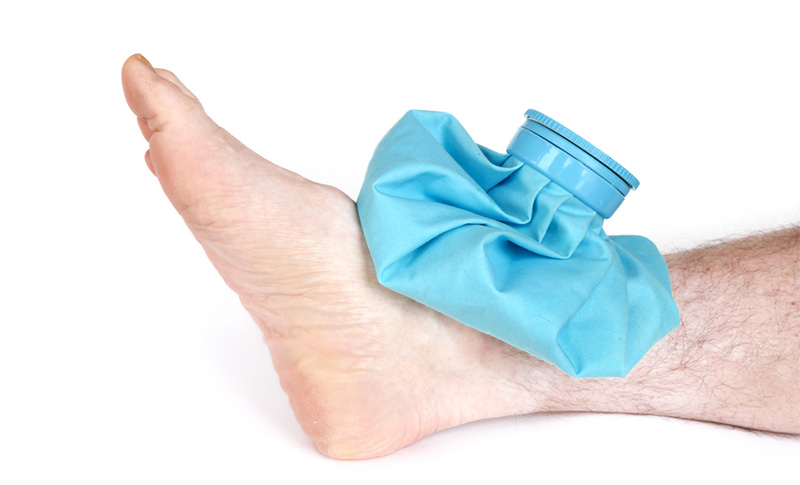You’ve undoubtedly seen it happen while watching a basketball game: a player jumps to grab a rebound and turns his foot as he lands awkwardly on his ankle. The player limps from the court, seeking help from the trainer. Ouch!
What the player has suffered is a sprained ankle. Everyone is familiar with the term, but what does it actually mean?
Ankle Sprains Explained
An ankle sprain is one of the most common injuries to the soft tissue of the ankle. It is estimated that approximately 100,000 Canadians suffer ankle sprains annually. In college and university sports, it is one of the most common injuries among both men and women.
An ankle sprain occurs when the ligaments, the bands of fibrous tissue that keep the ankle in place, are stretched or torn. It generally happens when the ankle is twisted, which can happen during an intense activity, such as a sport, or by simply losing your balance or stepping onto an uneven surface while walking.
A mild sprain results when the ligaments are simply stretched, a severe sprain occurs when the ligaments actually tear.
Sprained Ankle Symptoms
If you sprain your ankle, you can expect one or more of these symptoms:
- Pain.
- Bruising, resulting from ruptured blood vessels leaking into the tissue.
- Swelling, resulting as fluid continues to leak into the tissue for 24 hours after the injury.
- Tenderness when touched.
- Joint instability, especially if the ligament is torn through.
- A possible popping sound.
A severe sprain will exhibit symptoms similar to those of a broken bone and should receive immediate medical evaluation.
Diagnosis
During a physician’s physical examination of your ankle she or he will:
- Palpate. Gently press the area around the ankle to determine which ligaments are affected.
- Test range of motion. Move the foot in various directions to see which movements are possible.
- Use imaging. Images of your ankle may assist in diagnosis. X-rays can determine whether any bones are broken, while an ultrasound allows for observation as the ankle moves to see how much stability the ligament offers. Magnetic Resonance Imaging (MRI) may be used once swelling recedes to determine the extent of the injury.

Classification
Sprains are graded based on their severity – the amount of damage done to the ligaments. Grading is helpful to physiotherapists when they treat patients with sprains.
Grade 1 ankle sprain – mild
- Ligaments are stretched slightly and there may be microscopic tears.
- There is mild swelling, bruising and tenderness around the ankle.
Grade 2 ankle sprain – moderate
- The ligament is partially torn.
- Tenderness, bruising and swelling around the ankle are moderate.
- Ankle is abnormally loose if moved in certain directions.
Grade 3 ankle sprain – severe
- The ligament is torn through.
- Swelling, bruising and tenderness around the ankle are severe.
- With certain motions, there is substantial instability; unable to bear weight.
How to Heal a Sprained Ankle
Luckily for the injured, almost all sprained ankles can heal without surgery. However, healing will take time.
It is important not to treat a sprain lightly, because once an ankle has been sprained, it is more prone to further sprains. You may also experience stiffness and pain. Without proper rehabilitation, you may experience instability, which can lead other muscles to compensate. As a result, your gait may change, placing undue stress on your legs, knees or hips and making them more prone to injury.
Just as there are three grades of sprains, there are three basic steps to any ankle sprain treatment:
- Step 1: Rest, protection of the ankle and swelling reduction.
- Step 2: Restoring strength, flexibility and range of motion.
- Step 3: Maintenance exercises and a gradual return to sports.

Physiotherapy for Ankle Spain
Initially, any sprained ankle can be treated using the RICE method: rest, ice, compression and elevation. However, once the initial swelling has receded, it’s time to turn to a physiotherapist for a rehabilitation program that focusing on rebuilding strength, restoring flexibility and range of motion and promoting stability.
In addition to a series of targeted exercises, your physiotherapist may employ a hands-on treatment called joint mobilization to restore the gliding motion to the ankle bones. Your exercises may also home in on your sense of position or proprioception. Nerve sensors inside your ligaments may be affected during a sprain and they may not give your brain an accurate reading of how your ankle is positioned. You may need to retrain your sense of position as you heal.
How Long Does it Take a Sprained Ankle to Heal?
Sprains generally heal in three to eight weeks if given proper treatment, so handle with care!
